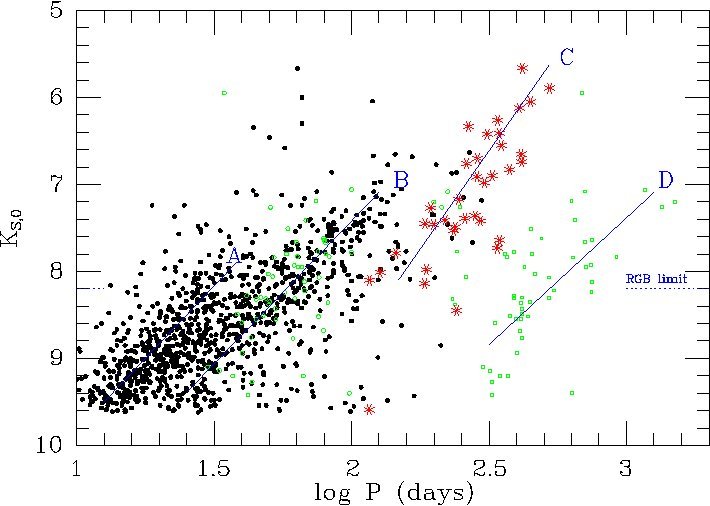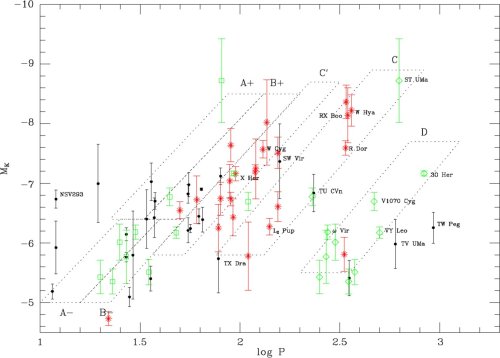Semi-regular variables
The Baade's Window Fields; work with the ISOGAL team
As an associate member of the ISOGAL collaboration, which used the ISOCAM camera on the ISO satellite to survey a large number of fields near the galactic plane and galactic centre, I proposed that the Baade's Window fields NGC6522 and SgrI should be looked at to provide fiducial fields for the more heavily obscured areas as they were relatively well studied. For example, they had already been surveyed photographically for red variable stars by Lloyd Evans (MNRAS, 174, 169, 1976) and part of the NGC6522 field had been surveyed for late-type M giants by Blanco (AJ, 91, 290, 1986). The analysis of the ISOGAL results from the Baade's Window fields (Glass et al MNRAS (Glass et al, MNRAS, 308, 127, 1999) yielded the following colour-magnitude diagram:

|
Composite ISOGAL Colour-Magnitude diagram for Baade's Windows NGC6522 and SgrI. [7] refers to the 7-micron band and [15] to the 15-micron band. From bottom left to top right the stars show increasing mass-loss, evinced by increasing radiation at 15 microns from cool dust shells. The Mira variables (solid black dots) are at the top. Suspecting that he may have overlooked some of the Mira variables, I asked Lloyd Evans to re-examine the stars marked with crosses on his original plates for large-amplitude variability, but no evidence for this was found. |
At this point I approached the MACHO collaboration for access to their variable star survey of the Baade's Window fields. They had accumulated of order 1000 measurements of about 20,000,000 stars in the galactic centre and the Magellanic Clouds. At this time their data was proprietary, but David Alves offered a collaboration, which proved very fruitful. It soon became evident that the ISOGAL stars with excesses were all variables.
The ISOGAL mid-infrared photometry (7 and 15 microns) was cross-correlated with about 300 stars in the Baade's Windows having MACHO V and R light curves. Their predominant periods were determined by Fourier analysis. It was found that they possess a wide and continuous distribution of pulsation periods and that they obey an approximate log P - Mbol relation or set of relations.
Approximate mass-loss rates were derived from ISOGAL mid-infrared photometry and models of stellar spectra adjusted for the presence of optically thin circumstellar silicate dust. The mass-loss rates were found to depend on luminosity and pulsation period. Some SR variables lose mass as rapidly as short period Miras but do not show Mira-like amplitudes. A period of 70 days or longer is a necessary but not a sufficient condition for mass-loss to occur.
The first results were given in ISO Surveys of a Dusty Universe , Springer Lecture Notes in Physics, No 548, eds Lemke et al, 2000, p363. The main paper in the names of the ISOGAL and MACHO consortia is ApJ, 552, 289, 2001.
Work with Mathias Schultheis
A further paper on the MACHO results concerning the Baade's Windows AGB stars, as seen in the IJHK region by DENIS and 2MASS, with M. Schultheis (IAP), is Asymptotic Giant Branch variables in Baade's Windows , MNRAS, 327, 1193, 2001. The dependence of their IJHK colours on period and on the presence or absence of mass loss were discussed.
A complete sample of M giants in the NGC6522 Baade's Window (all with
MACHO data and objective prism spectra) was used to establish some general
properties of cool Bulge stars. Variability, near-IR and mid-IR data were
combined to show that just about all late M-type stars show variability and
mass loss. See Glass and Schultheis M Giants in MACHO, DENIS and ISOGAL
, MNRAS, 337, 519, 2002.

The paper Period-magnitude relations for M giants in Baade's Window NGC6522 , Glass and Schultheis, MNRAS, 345, 39, 2003, takes a large sample (over 1000) of late-type variables in NGC6522 and shows that the four distinct period-luminosity sequences found by P.R. Wood et al (IAU Symposium 191, p.151, 1999) in the LMC for late-type variables can also be seen in the Milky Way galaxy. This had not been obvious with smaller samples.
A paper Late-type giant variables in NGC6522, LMC and SMC. How do they differ? compares the colour-magnitude diagrams, K logP diagrams etc in these three fields, for absolute K mags more luminous than a certain level. The populations differ in several ways: for example, the fraction of stars that vary and the amplitudes of variation of the SRVs are lower in the Magellanic Clouds than in NGC6522. See Schultheis, Glass and Cioni (A and A, 427, 945, 2004).
SRVs in the Solar Neighbourhood
The existence of trigonometric parallaxes for a number of semi-regular variables in the vicinity of the Sun allows an absolute calibration to be made. Van Leeuwen has recently completed a revision and improvement of the results from the Hipparcos satellite (Hipparcos, the New Reduction of the Raw Data, Springer, 2007).
|
|
Semiregular variables in the Solar Neighbourhood uses the revised Hipparcos parallaxes for local semiregular variables with well-determined periods to show that they occupy similar parts of the K, logP diagram to those of the NGC6522 field. See Glass and van Leeuwen, MNRAS, 378, 543, 2007. This diagram shows all stars with Hipparcos parallaxes better than 3 sigma. Here the red points are the larger-amplitude SRVs (not Miras). The green ones have short and long periods and the black dots are others. The lettered parallograms are the refined Magellanic Cloud SRV loci taken from Ita et al MNRAS, 353, 705 |
Mid-IR period-magnitude relations for AGB stars
I.S. Glass, M. Schultheis, J.A.D.L. Blommaert, R. Sahai, M. Stute, S. Uttenthaler
MNRAS, 395, L11, 2009
Asymptotic Giant Branch variables are found to obey period-luminosity relations in the mid-IR similar to those seen at K_S (2.14microns), even at 24microns where emission from circumstellar dust is expected to be dominant. Their loci in the M, logP diagrams are essentially the same for the LMC and for NGC,6522 in spite of different ages and metallicities. There is no systematic trend of slope with wavelength. The offsets of the apparent magnitude vs. logP relations imply a difference between the two fields of 3.8 in distance modulus. The colours of the variables confirm that a principal period with log P > 1.75 is a necessary condition for detectable mass-loss. At the longest observed wavelength, 24microns, many semi-regular variables have dust shells comparable in luminosity to those around Miras. There is a clear bifurcation in LMC colour-magnitude diagrams involving 24 micron magnitudes.
